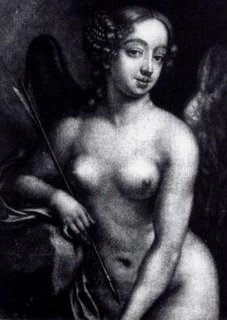Is this (formally) a portrait of a living person (as opposed to a painting of some historical or genre scene that Peg Hughes happened to model for Lely) and if so what are the social parameters of breast-baring in 17thc female portraiture? Would it be usual for a genteel lady to be painted with a nipple showing? If not (or if so) does it carry some meaning about the sitter's status e.g. as married/unmarried, mother, virgin, mistress, prostitute, bluestocking, actress?Of course, I'm not the person to ask, since I've always regretted not having studied art history on anything like a formal basis – but my own viewing of Restoration portraiture of women suggests, as Catherine MacLeod writes, that "While in practice there is almost never any distinction between the poses Lely used to portray 'virtuous' women and those with more dubious reputations, portraits that include bare breasts seem exclusively to depict mistresses." (See this lively review of a 2003 exhibition of Restoration portraits of women.)
 The graceful Lely portrait of Diana Kirke (left) was reputed banned from the London Underground on the grounds that the exposure of her left nipple might be "distracting" to commuters. Kirke had a 13-year liaison with Aubrey de Vere, Earl of Oxford, & the Yale art historians speculate "It is likely that her lover commissioned the portrait for his private apartments, where it would be seen and admired only by his inner circle of friends." (The Kirke portrait was replaced on the Tube by an equally lovely but more discreet portrait of the Duchess of Richmond.)
The graceful Lely portrait of Diana Kirke (left) was reputed banned from the London Underground on the grounds that the exposure of her left nipple might be "distracting" to commuters. Kirke had a 13-year liaison with Aubrey de Vere, Earl of Oxford, & the Yale art historians speculate "It is likely that her lover commissioned the portrait for his private apartments, where it would be seen and admired only by his inner circle of friends." (The Kirke portrait was replaced on the Tube by an equally lovely but more discreet portrait of the Duchess of Richmond.)Of all of the women painted by Lely, the only one I know of to appear in full undress is of course Nell Gwyn, another actress & the most famous of Charles II's mistresses.
 (And a woman of considerable spunk: when an angry mob assaulted her carriage, believing it contained a less popular – and Catholic – paramour of Charles's, she said, "Pray good people, be civil; I am the Protestant whore.") Samuel Pepys reputedly kept an engraving of Peter Cross's portrait of Gwyn as Cupid (right) over his desk at the Admiralty.
(And a woman of considerable spunk: when an angry mob assaulted her carriage, believing it contained a less popular – and Catholic – paramour of Charles's, she said, "Pray good people, be civil; I am the Protestant whore.") Samuel Pepys reputedly kept an engraving of Peter Cross's portrait of Gwyn as Cupid (right) over his desk at the Admiralty.As to whether their clothes "fit," I suppose they fit as well (or badly) as those of my own undergraduates; and whether something gets exposed (as with my own undergraduates) is a matter of a delicate semiotic – a rather different semiotic, d.g., now than then.
4 comments:
Fascinating.
My Buffalonian undergrads were pretty well-clad, but I suppose it's different in SoFL. We had pretty strict standards for dress in high school, so I'm kind of a prude about it. Anyway, thinking back on the 18th/19th c portraiture I've seen of women, they're generally family portraits where the women are fully clothed, Renaissance-style portraits of working-class women, also fully clothed (the virtuous maid, the hardworking mother). It would be interesting to see a large collection of portraits of mistresses.
The expression on Peg's face and the presence of the dog undermine, for me, any eroticism with regard to the nipple (as we're all trained in the "male gaze" i think this is a fair comment, although perhaps i wouldn't be as drawn to an exposed nipple as most men). There's such a disconnect between her skeptical/reserved expression, her hand not indulging the dog's request, and then suddenly--nipple!
I'd also like to see the variety of breasts in paintings such as this one. Seems like about a B-cup is the way to go with a mistress. Is there a standard breast size considered beautiful and portrayed regardless of reality, or is this realistic portraiture?
In that VQR article, Antonia Fraser has consistently become Antonia Eraser, a sort of pentimento perhaps.
Good eye, Edmund! A paradox -- a palimpest that simultaneously erases & preserves the original...
So far as cup sizes go, Jessica, I suspect that it's a matter of period fashion more than realistic portraiture, just as the men in classical statuary seem to be quite unrealistically meagerly endowed. It's unclear what that means: seems to me I read somewhere that classical statues have small genitals to imply that the men represented have in some sense transcended their animal natures; middling-to-small breasts on upper-class courtesans in the 17th century, on the other hand, work to set them apart from the working classes for whom reproduction & childrearing are such an arduous portion of their lot. Large breasts, that is, would probably be associated with a wet-nurse rather than a sexy actress.
Interesting... (I don't mean to be gauche in my questions, but I just saw a documentary on exaggeration in representational art on PBS, and I got a Victoria's Secret catalog in the mail today.)
Antonia Eraser--wonderful, sounds like a lost character from Ada or Ardor
Post a Comment